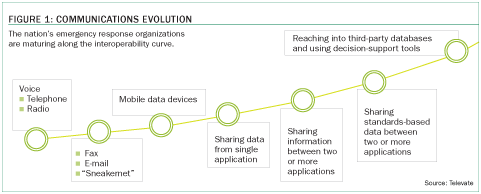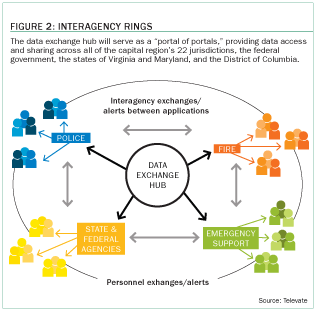Expanding horizons
The term “interoperability” has taken on enormous meaning and consequence for public-safety communications. Threats from terrorist attacks and other manmade or natural hazards require emergency responders and government and non-government decision-makers to effectively manage prevention, protection, response and recovery activities.
The ability to manage these emergency tasks depends in part on the availability of interoperable emergency communications systems and applications that can support real-time radio communications and exchange operationally useful information between response agencies and other organizations — both within and across the affected area, which typically affects multiple jurisdictions.
Figure 1 illustrates the various stages of interoperable communications, both voice and data. Emergency responder communications requirements are defined by the complexity of events such as the terrorist attacks on the World Trade Center and the Pentagon and natural disasters such as Hurricane Katrina. Emergency responders require the support of robust radio, broadband wireless and fiber optic networks, combined with dependable access to, and sharing of, mission-critical data. The ability to achieve advanced stages of information interoperability is the next challenge.

Radio interoperability is of paramount importance to the first responder community. The topic of extensive research and debate, interoperability is a major focus of federal, state and local public-safety technology investments. Advancing voice communications interoperability has been the primary objective of public-safety licensees for decades. The challenges of radio interoperability are quite obvious to system designers, technicians, manufacturers, the FCC and end-users. These challenges include:
-
Disparate frequencies at VHF, UHF, 700 MHz and 800 MHz.
-
Absence of affordable network multi-technology, multi-spectral end-user radios.
-
Limitations of network standards.
-
Radio network deployment strategies focused on the jurisdiction in lieu of a regional, state or national architecture.
-
Differences of opinion on how best to achieve radio interoperability.
Individually and collectively, these challenges affect achieving optimal interoperability. Public-safety radio personnel, information technologists and vendors have implemented a variety of innovative solutions to advance voice communications because such communication is essential to first responders. Consequently, radio interoperability technology has advanced significantly. Today, the primary obstacle to achieving interoperability is the actual implementation itself, although funding issues are still a factor.
But while the lives of first responders and of those they protect depend on interoperable voice communication, these same responders have a similar — perhaps even more compelling — requirement for real-time, anytime, anywhere access to mission-critical data. Access to, and sharing of, such information across local, state and federal jurisdiction boundaries; across agencies; and across all technical and administrative boundaries are essential to the emergency responder community.
At its most elementary level, data interoperability means having the ability to send and receive information, typically through the use of fax, e-mail and other simple means of exchange. Another basic level of data interoperability is defined by standardizing single Web-based applications, such as crisis information management systems, computer-aided dispatch systems, geographic information systems (GIS) and others.
For the purposes of this article, data interoperability is defined as the exchange or query of structured data from one responder agency application to an application used by another responder agency. Data interoperability must be supported regardless of the type, structure or other variables unique to the information. This interoperability must transpire regardless of whether responder agencies are using the same or differing applications, or wired or wireless transport media.
There are significant challenges to achieving data interoperability:
-
Disparate legacy applications and databases incapable of direct information-sharing.
-
Absence of common naming conventions for public-safety resources.
-
The lack of, or the lack of adherence to, public-safety data standards.
-
Commitment of responder agencies within and across jurisdictional boundaries to share information.
-
Challenges concerning security and governance between jurisdictions.
While these challenges are significant, they are not insurmountable. Federal agencies including the Department of Justice and the Department of Homeland Security, together with local and state public-safety entities, universities and vendors, are designing and implementing advanced information-sharing technology and data standards to guide the advancement of data interoperability. A prime example of public-safety data standardization to enhance interoperability is the National Information Exchange Model. NIEM is designed to develop, disseminate and support information exchange standards to effectively share critical information in emergency situations.
Emergency responder data exchange requirements vary from agency to agency, depending on each agency’s specialized functions. But police, fire, emergency medical, emergency management, health and medical, and transportation also share many common requirements. Law enforcement requirements for access to local, regional and national criminal databases, as well as motor vehicle and driver license data, are as essential to its mission as the ability to report and analyze disease information and monitor patient tracking is for health and medical professionals.
Similarly, access to crucial data, including building architectural drawings and on-scene video, enables firefighters to perform their life-saving work more efficiently and safely. Emergency managers also need real-time access to an extensive array of information to better coordinate their efforts and improve their ability to deploy the appropriate available resources in complex situations.
The National Capital Region Interoperability Program (NCRIP) is a comprehensive data interoperability program designed to provide emergency responders and all emergency support function personnel in the Washington, D.C., region with advanced information access and exchange capabilities. The NCRIP leverages a government institutional fiber optic network known as INET throughout the region to facilitate secure and reliable connectivity and information transport. Additionally, the program includes the implementation of a Regional Wireless Broadband Network that will provide desktop mobility capabilities to the region’s responder community. The network will facilitate wireless high-speed, multimedia functionality throughout the region’s 2500-square-mile footprint by interconnecting to the INET where available.
Information interoperability will be achieved via a data exchange hub (DEH) that will serve as a “portal of portals,” providing data access and sharing across all of the region’s 22 jurisdictions, the federal government, the states of Virginia and Maryland, and the District of Columbia. The DEH is being designed as a service-oriented architecture (SOA) network to support various Web services for all responder agencies.
The SOA is supported by an enterprise service bus technology that efficiently enables the sharing of information across disparate applications and database structures via extensible markup language (XML) data-message structuring. In the future, the region will aggressively adopt NIEM data standards to simplify data exchanges. Jurisdictional data will be accessed across the region through a secure authentication process. Specific data will not be centrally deposited, as the DEH will support data query and information analysis but not central aggregation. In addition, a regional GIS map is included in the system to support situational awareness viewing throughout the region and beyond.
Figure 2 presents a basic illustration of the DEH functionality. Authorized DEH users will be provided rights to access and share information via the hub. Data interoperability will be supported at the inter- and intrajurisdictional levels and will address the specialized requirements of all responder agencies. The expectations are that the DEH will support both day-to-day and critical emergency events on a cross-regional basis, and each jurisdiction will rely on the hub to support regular information exchange requirements.

Data interoperability is an essential tool for the emergency responder community. Mission-critical information must be available to responders both in the field and at the command/dispatch center over secure and reliable wireless and wired infrastructure. The challenges to the implementation of true data interoperability are as complex and diverse as the entities such systems are designed to serve.
Threats of terrorism attacks and large-scale natural catastrophes warrant the advent of large area and regional communications and information technology networks, with robust and reliable tools, to meet the nation’s need for data interoperability. Police, fire and emergency medical agencies, as well as myriad other organizations that work directly with the emergency response community, have an urgent need for efficient and timely data information and sharing.
Rick Burke is managing partner of Televate LLC, a public-safety information technology firm headquartered in McLean, Va. He can be reached at [email protected].

















